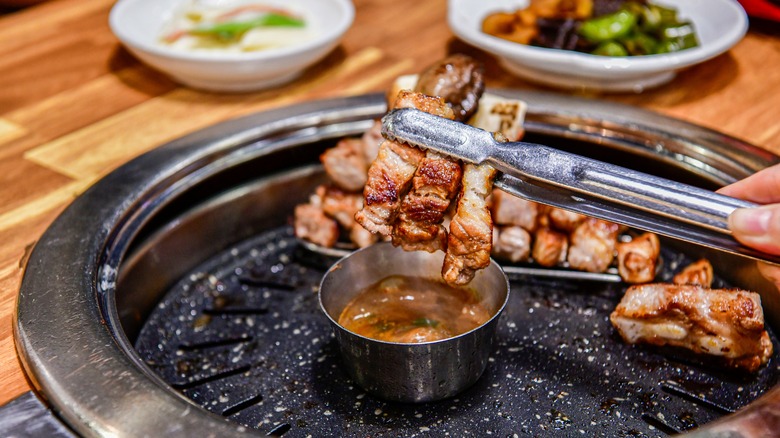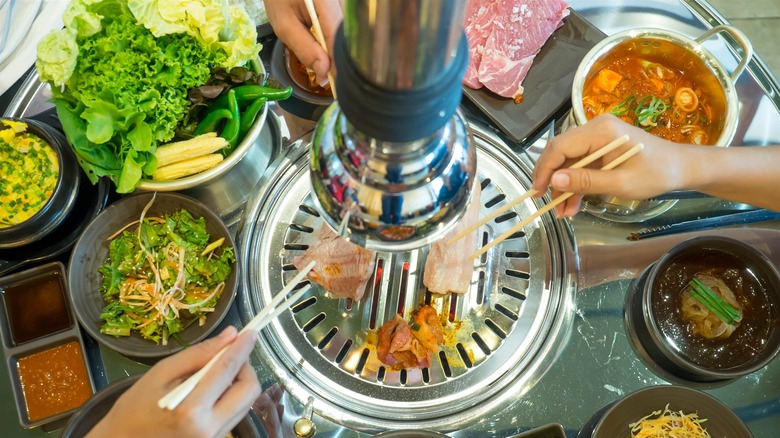The Korean BBQ Dish That Symbolizes Celebration And Friendship
Korean BBQ is designed to be a social experience, offering not just communal dining but also communal cooking to forge jeong, a deep emotional connection between people. Guests get to select their choice of meat cuts to place on the grill that's installed at the center of the table and cook them the way they want, flipping them with tongs or chopsticks. They then offer portions of cooked meat to others so everyone gets to taste it. The grill can be powered by either gas, charcoal, or electricity, but hosting a Korean BBQ at home with a hot grill plate is a budget-friendly option, too.
A popular cut of meat for Korean BBQ is pork belly. Koreans call it samgyeopsal, which translates to three-layered meat, and its defined tiers of skin, fat, and flesh create an indulgent sizzle and flavor when grilled. Grilled pork belly, or samgyeopsal-gui, has been a symbol of celebration in Korea since locals began treating it as anju, food meant to be consumed with alcohol, in the 1980s.
With its smoky, fatty richness, samgyeopsal-gui is one of the traditional dishes to pair with soju, Korea's signature fermented rice drink. People would also dunk a soju shot in beer to make the cocktail somaek, another popular accompaniment to this Korean BBQ dish. Since pork is more affordable than beef, sharing samgyeopsal-gui and soju, whether in a restaurant or at home, became a tasty, inexpensive way for Koreans to socialize after work as well as celebrate special occasions.
Samgyeopsal has its own holiday in Korea
Historically, pork wasn't Korea's favorite protein. In an interview with Korea Exposé, food expert, professor, and author Joo Young-ha, explained most locals used to believe that consuming pork caused graying hair and left people vulnerable to parasitic diseases. Pork belly was one of the commonly discarded parts, even by those who did eat pork. It was only during the '70s that certain communities discovered how to grill and eat this specific cut out of economic necessity: the job-seeking migrants living near Yeouido Island in Seoul and people in Busan who were part of Korea's meat export market. Samgyeopsal turned out to be a disfavored cut in Japan, leaving Korean slaughterhouse operators with surplus meat.
Unsuccessful exports to Japan lowered the price of pork in Korea and increased its popularity, which continued to grow after a nationwide beef shortage in the 1980s. As pork was more affordable, the government promoted its consumption. It helped that Koreans who still remembered the food scarcity during World War II and the Korean War linked eating meat with abundance.
Soon, grilled samgyeopsal became so popular that coal miners began believing its fat could wash down the build-up of dust in their throats. Although there's no proven scientific basis for this, it remains a widespread belief in Korea, with samgyeopsal sales rising on days of thick smog. Koreans also commemorate their love for pork belly on Samgyeopsal Day, celebrated with friends and family every March 3 in honor of the meat cut's three-layered structure.

